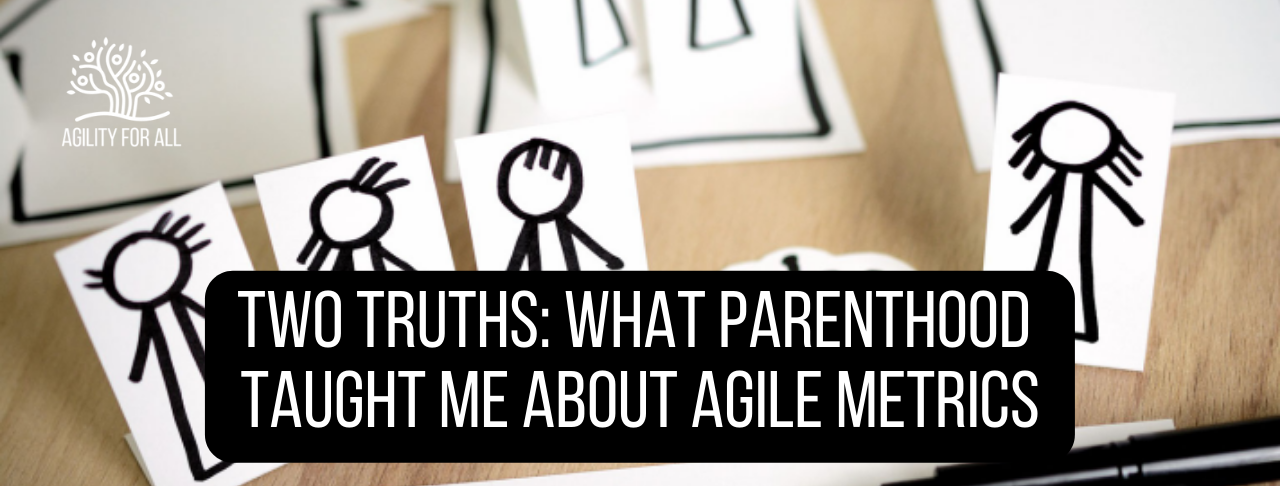
Two Truths: What Parenthood Taught Me about Agile Metrics
03/03/2021
In August of 2020 we welcomed our first child into our small but growing family. The last six months have been a nonstop roller coaster of learning opportunities – not to mention healthy doses of panic, joy, frustration, excitement, and can-you-believe-what-we-did-oh-my-god-we-have-a-child-now moments.
But what has surprised me most of all is how many of those lessons directly relate to the concepts of Agile and Lean. After whittling down a surprisingly lengthy list of potentials, I’ve chosen to focus on just one: metrics.
For those who may not know, the world of infant care is flooded with metrics. Everything from his furry head to his tiny toes has been measured, weighed, plotted, analyzed, compared, and recorded. One of the first things we do upon learning a brand new life has entered this world is report out on their weight and length. Many metrics have power over the parents and the child; a hundredth of a point can be the difference between having a label versus not, and in rare cases, even between a life saved and a life lost.
One of the most influential metrics in a newborn’s life is their weight. Oftentimes the all-important “weight question” dominates the early weeks and months: Is the Baby Gaining Well? Being planners, my husband and I rented a hospital-grade scale in advance of his birth. This thing is a powerful piece of tech with the ability to measure the difference of a tenth of an ounce. Combined with an at-home printout of the WHO’s weight gain chart, our goal was to leverage this measurement as an early warning system.
Over-leveraging Metrics
And leverage it we did. Every day, sometimes multiple times a day, we would weigh him. Did he just poop? Weigh him again. Before a feeding? Load him up. After the feeding? Pop him back on. We obsessed over every miniscule gain and loss, and armed with a scale that could detect it, there were days when we found ourselves fretting, weighing and re-weighing, hoping for what we perceived to be better outcomes within the span of just a few hours.
It was only months later that I was struck by the similarities in how we were choosing to use (or abuse) this metric and how I’ve seen organizations historically misuse them. I had fallen into two of the many Metrics Traps I’d so often cautioned my clients to avoid. Once the “Ah-ha” moment sunk in and we course-corrected, our approach completely transformed for the better. Our anxiety levels dropped, our joy in parenthood increased exponentially, and best of all, our son thrived. Here are the two truths about metrics that our son helped me relearn:
-
Metrics are at best meaningless, and at worst harmful, unless gathered at the right tempo or frequency.
-
Metrics will only ever tell you part of the story; they must always be combined with the non-numerical bigger picture for them to depict the true story.
Gathering at the Right Tempo
Unknowingly, my husband and I had fallen into the classic trap of “the more the better,” while our obsessive-compulsive weighing schedule was harming rather than helping our cause. When you can see fluctuations every time a measurement is taken it can be tempting to run and re-run the numbers, looking for miniscule signs of improvements... or issues. With a scale that could measure the tiniest changes, our weighing him multiple times a day was producing largely meaningless data that was obscuring, rather than revealing, the overall positive trend. When we pulled back from the multiple-times-a-day weighs and converted to a once-a-month plan, the numbers made far more sense and a trend became discernible. Not only did the data become more useful, we earned back a ton of time and energy that could now be spent on far more productive ends.
The parallels between our experience and how I’ve seen organizations leverage metrics are all too clear – in an attempt to harness data and prove that the Agile transformation has “paid off,” some programs will run and re-run the numbers far more frequently than is useful or healthy. While every context will be different, some examples could include checking the sprint burndown chart or a team’s cumulative flow diagram more than once a day, or calculating progress towards a 6-month release effort every week when sprints are only two weeks long.
Seeing the Bigger Picture
The numbers undeniably matter, but qualitative measurements and observations should matter too. Because they’re often harder to visualize and collect, they tend to fall by the wayside. My husband and I were so absorbed by the weight measurement that we were completely ignoring all the other signs that our son was on the right track. A simple observation would reveal that he was active, energetic, happy, and according to his diaper output, extremely hydrated. We had blinded ourselves to the bigger picture, and because we did not consider these observations along with the ounces, we caused ourselves unnecessary stress and came to faulty conclusions.
Looking at reports on team metrics will give you different information than sitting in with the team for a day. No matter how comprehensive the metrics feel, they will never replace the insights you can gather from conversations and observations. The danger lies in believing that the numbers tell you all you need to know. Kanban has a term for this: Gemba, which means “actual place” in Japanese. A “Gemba walk” is when a manager or executive literally walks the floor where their employees are working so that they can observe, converse, and learn from their people. Both objective data and an actual floor walk are necessary to learn how a team or project is faring.
Takeaways
I knew that parenthood would have a lot to teach me, but I could not anticipate how relevant my work background would turn out to be. My personal takeaway is that it pays to take a step back and check in on your own practices every so often. I encourage you to take a look at how you are leveraging metrics in your own contexts, be they personal or business – are you measuring at the right frequency? Are you keeping in mind the bigger picture? If this is a taste of what the coming years have to offer, I can’t wait to find out what our son will teach us next.
Are you ready to work with your team to create the culture that you want? Join us for one of our group coaching programs and get started with change today.
Learn More
About the Author:
 SARAH FRIEDMAN-CINTRON
SARAH FRIEDMAN-CINTRON
Sarah Friedman-Cintron is the founder of SFC Coaching, a small shop providing Lean and Agile coaching and training to enterprises, teams, and individuals. She has served in the commercial and government realms and leverages a practical, incremental approach to work culture improvements, transformations, and personal/professional growth.
Connect with us
 |
 |
 |
Search

WELCOME TO THE AFA LEARNING PORTAL
We offer loads of free information here in the blog and also in our
resource library
AFA provides coaching, consulting, and training programs. In addition to specialized consulting, you have the option to choose from:
- group coaching programs
- masterclasses
- 1-week intensive offsites
Our programs are designed to help your organization to:
- Maximize Employee Engagement
- Foster Self-Organization
- Encourage Innovation
- Attain Higher Performance
- Be More Agile
